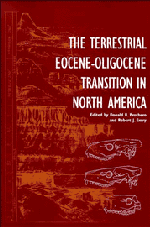Book contents
- Frontmatter
- Contents
- Contributors
- Preface
- PART I The Chronostratigraphy of the Uintan through Arikareean
- PART II Common Vertebrates of the White River Chronofauna
- 16 Testudines
- 17 Squamata
- 18 Ischyromyidae
- 19 Cylindrodontidae
- 20 Castoridae
- 21 Canidae
- 22 Nimravidae
- 23 Amphicyonidae
- 24 Small Arctoid and Feliform Camivorans
- 25 Merycoidodontinae and Miniochoerinae
- 26 Leptaucheniinae
- 27 Leptomerycidae
- 28 Camelidae
- 29 Hyracodontidae
- Summary
- Index
20 - Castoridae
Published online by Cambridge University Press: 06 July 2010
- Frontmatter
- Contents
- Contributors
- Preface
- PART I The Chronostratigraphy of the Uintan through Arikareean
- PART II Common Vertebrates of the White River Chronofauna
- 16 Testudines
- 17 Squamata
- 18 Ischyromyidae
- 19 Cylindrodontidae
- 20 Castoridae
- 21 Canidae
- 22 Nimravidae
- 23 Amphicyonidae
- 24 Small Arctoid and Feliform Camivorans
- 25 Merycoidodontinae and Miniochoerinae
- 26 Leptaucheniinae
- 27 Leptomerycidae
- 28 Camelidae
- 29 Hyracodontidae
- Summary
- Index
Summary
ABSTRACT
North American Eocene-Oligocene beavers compise 18 species in 7 genera, including one new genus (Nannasfiber) and 5 new species (Capacikala parvus, Capatanka minor, Euhapsis luskensis, Nannasfiber ostellatus, and Nannasfiber osmagnus). They can be divided into three groups. The first includes only Agnotocastor; the second group consists of Palaeocastor and Capacikala; the third group includes Capatanka, Euhapsis, Nannasfiber, and Fossorcastor. Differences among the three groups are recognized from skull, mandible, and dental patterns. During their evolution in the Chadronian through the Arikareean, dental pattern becomes simpler, and skull shape becomes diversified.
The only beaver represented in the Chadronian and Orellan is Agnotocastor, which survived into the carliest Arikareean. Palaeocastor first appeared in the Whitneyan, but was most abundant in the early Arikareean. A radiation of beavers took place in the early Arikareean when 4 castorid genera (Capacikala, Capatanka, Euhapsis, and Fossorcastor) first appeared. The rapid evolution and radiation of the Arikareean beavers make them excellent biochronological correlation tools. Palaeocastor and Capatanka are significant references for the early early Arikareean; Capacikala comes from the early Arikareean; Nannasfiber implies an early late Arikareean age; Euhapsis and Fossorcastor are known from the late early through late late Arikareean.
INTRODUCTION
The North American Eocene-Oligocene beavers range from the Chadronian through the Arikareean. Previously described genera include Agnotocastor, Palaeocastor, Capacikala, Capatanka, Euhapsis, Pseudopalaeocastor, and Fossorcastor (Stirton, 1935; Wilson, 1949a, b; Emry, 1972; J. Macdonald, 1963, 1970; L. Macdonald, 1972; Martin, 1987).
- Type
- Chapter
- Information
- The Terrestrial Eocene-Oligocene Transition in North America , pp. 417 - 432Publisher: Cambridge University PressPrint publication year: 1996
- 4
- Cited by

